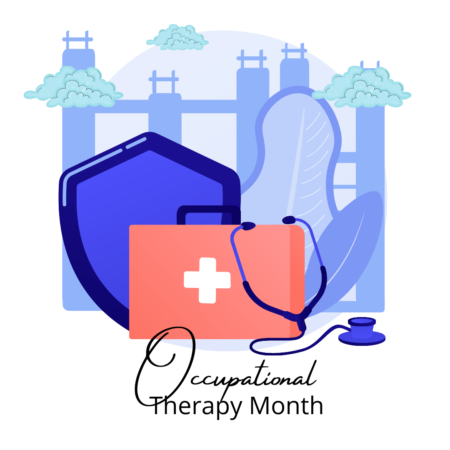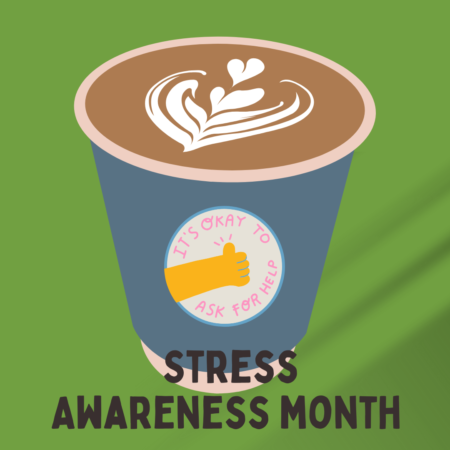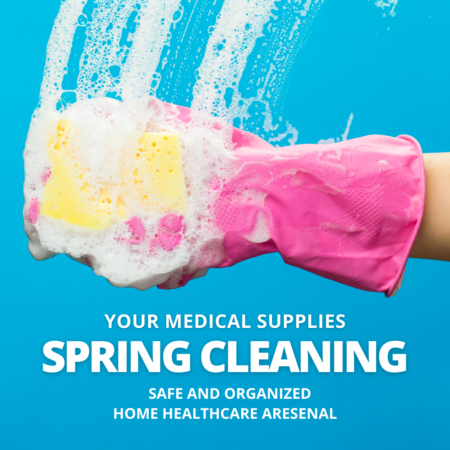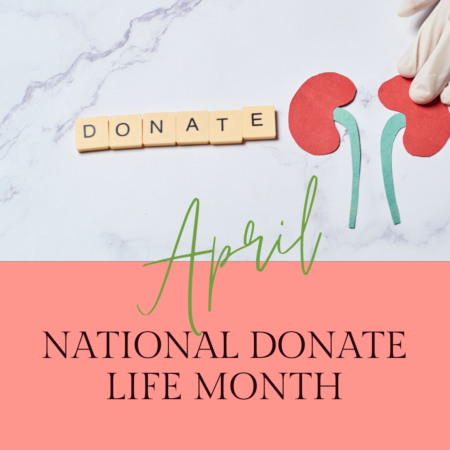Prism Post
 April is National Occupational Therapy Month, a time to recognize and celebrate the invaluable contributions of occupational therapists in helping individuals live life to the fullest. Occupational therapy (OT) plays a crucial role in improving daily living skills, promoting independence, and enhancing quality of life for people of all ages and abilities. From children with developmental delays to seniors recovering from injuries, occupational therapists empower individuals to overcome challenges and achieve their goals. In honor of National Occupational Therapy Month, let’s explore the importance of OT and showcase some innovative products that can aid in therapy sessions.
April is National Occupational Therapy Month, a time to recognize and celebrate the invaluable contributions of occupational therapists in helping individuals live life to the fullest. Occupational therapy (OT) plays a crucial role in improving daily living skills, promoting independence, and enhancing quality of life for people of all ages and abilities. From children with developmental delays to seniors recovering from injuries, occupational therapists empower individuals to overcome challenges and achieve their goals. In honor of National Occupational Therapy Month, let’s explore the importance of OT and showcase some innovative products that can aid in therapy sessions.
The Role of Occupational Therapy: Empowering Independence and Enhancing Well-being
Occupational therapy is a holistic and client-centered approach to healthcare that focuses on enabling individuals to participate in meaningful activities and occupations. Occupational therapists work with people of all ages and abilities to address physical, cognitive, sensory, and emotional challenges that may impact their daily functioning. By developing personalized treatment plans and using evidence-based interventions, occupational therapists help clients improve their:
- Self-care Skills: OT interventions target activities of daily living (ADLs) such as bathing, dressing, grooming, and feeding, helping individuals regain independence in self-care tasks.
- Mobility and Motor Skills: Occupational therapists address issues related to mobility, coordination, and fine motor skills, enabling clients to navigate their environments safely and effectively.
- Cognitive Abilities: OT interventions focus on enhancing cognitive functions such as attention, memory, problem-solving, and executive functioning, facilitating improved performance in school, work, and daily activities.
- Sensory Integration: For individuals with sensory processing difficulties, occupational therapists use sensory integration techniques to help regulate sensory input and improve participation in daily activities.
- Social Participation: Occupational therapists promote social skills, interpersonal communication, and community engagement, fostering meaningful relationships and connections.
Innovative Products for Occupational Therapy Sessions
In addition to personalized interventions and therapeutic techniques, occupational therapists often utilize innovative products and assistive devices to support their clients’ goals and facilitate progress in therapy sessions. Here are some examples of products commonly used in occupational therapy:
- Adaptive Equipment: Adaptive equipment such as dressing aids, reachers, and buttonhooks help individuals with limited mobility or dexterity perform daily tasks independently.
- Sensory Tools: Sensory tools like fidget toys, weighted blankets, and sensory brushes provide sensory input and promote self-regulation for individuals with sensory processing difficulties.
- Assistive Technology: Assistive technology devices such as adaptive keyboards, voice recognition software, and specialized computer interfaces enable individuals with disabilities to access and interact with technology more effectively.
- Therapeutic Toys and Games: Therapeutic toys, puzzles, and games are used to facilitate skill development, promote cognitive engagement, and encourage social interaction during therapy sessions.
- Home Modifications: Occupational therapists may recommend home modifications such as grab bars, shower benches, and wheelchair ramps to improve accessibility and safety within the home environment.
National Occupational Therapy Month is an opportunity to recognize and honor the dedicated occupational therapists who make a positive difference in the lives of individuals and families every day. By empowering independence, promoting participation, and fostering well-being, occupational therapy transforms challenges into opportunities for growth and achievement. As we celebrate OT Month, let us also acknowledge the importance of innovative products and assistive devices that enhance therapy sessions and support clients on their journey to greater independence and fulfillment. Together, let’s continue to champion the transformative power of occupational therapy and its profound impact on individuals, communities, and society as a whole
 From April 24th to April 30th, National Infertility Awareness Week shines a spotlight on a topic that affects millions of individuals and couples worldwide. Infertility can be a challenging and emotionally taxing journey, yet it often goes undiscussed and stigmatized. During this week, we come together to raise awareness, offer support, and provide resources for those struggling with infertility. In this blog post, we’ll explore the journey of infertility, offer support and resources, and discuss medical supplies that may be helpful during fertility treatments.
From April 24th to April 30th, National Infertility Awareness Week shines a spotlight on a topic that affects millions of individuals and couples worldwide. Infertility can be a challenging and emotionally taxing journey, yet it often goes undiscussed and stigmatized. During this week, we come together to raise awareness, offer support, and provide resources for those struggling with infertility. In this blog post, we’ll explore the journey of infertility, offer support and resources, and discuss medical supplies that may be helpful during fertility treatments.
Infertility is defined as the inability to conceive after one year of unprotected intercourse (or six months for women over 35) or the inability to carry a pregnancy to term. It affects individuals and couples from all walks of life, regardless of age, race, or socioeconomic status. The journey of infertility can be emotionally challenging, filled with uncertainty, grief, and frustration. However, it’s essential to remember that you are not alone, and there is support and resources available to help you navigate this journey.
If you or someone you know is struggling with infertility, know that there is support available. Here are some resources to consider:
- Support Groups: Joining a support group for individuals or couples experiencing infertility can provide a safe space to share experiences, offer and receive support, and connect with others who understand what you’re going through.
- Online Communities: There are numerous online forums and communities dedicated to infertility where individuals can share their stories, ask questions, and find support from others facing similar challenges.
- Counseling and Therapy: Seeking support from a qualified therapist or counselor who specializes in infertility can help individuals and couples navigate the emotional toll of infertility and develop coping strategies for managing stress and grief.
- Fertility Clinics and Specialists: If you’re considering fertility treatments, seeking guidance from a fertility clinic or reproductive specialist can provide valuable information about available options, treatment protocols, and success rates.
- Educational Resources: Educate yourself about infertility and available treatment options through reputable sources such as fertility clinics, medical organizations, and infertility advocacy groups.
For individuals undergoing fertility treatments, certain medical supplies may be helpful in the process. Here are some examples:
- Ovulation Predictor Kits: Ovulation predictor kits (OPKs) can help individuals track their menstrual cycles and identify the most fertile days for conception.
- Fertility Monitors: Fertility monitors are electronic devices that track hormone levels in urine or saliva to predict ovulation and identify fertile days.
- Fertility Medications: Fertility medications such as injectable hormones, oral medications, and vaginal suppositories may be prescribed as part of fertility treatments to stimulate ovulation or improve egg quality.
- Syringes and Needles: For individuals undergoing injectable fertility treatments, syringes and needles are necessary for administering medications as prescribed by a healthcare provider.
- Ultrasound Machines: Fertility clinics may use ultrasound machines to monitor follicle development and assess the uterus and ovaries during fertility treatments such as in vitro fertilization (IVF) or intrauterine insemination (IUI).
During National Infertility Awareness Week, let’s break the silence surrounding infertility and offer support and compassion to those on this journey. Whether you’re struggling with infertility yourself or supporting a loved one, know that there are resources, support groups, and medical professionals available to help you navigate this challenging journey. By coming together as a community, we can raise awareness, reduce stigma, and provide support and hope to individuals and couples facing infertility. Remember, you are not alone, and there is hope for the future.
 Earth Day, observed annually on April 22nd, serves as a global reminder of the importance of environmental protection and sustainability. As we strive to make positive changes in our daily lives to reduce our environmental footprint, it’s essential to consider the impact of industries, including healthcare, on the planet. In this blog post, we’ll explore eco-friendly medical supply options and sustainable practices in the industry, highlighting the importance of reducing waste and environmental impact.
Earth Day, observed annually on April 22nd, serves as a global reminder of the importance of environmental protection and sustainability. As we strive to make positive changes in our daily lives to reduce our environmental footprint, it’s essential to consider the impact of industries, including healthcare, on the planet. In this blog post, we’ll explore eco-friendly medical supply options and sustainable practices in the industry, highlighting the importance of reducing waste and environmental impact.
The Environmental Impact of Healthcare
While healthcare plays a vital role in promoting well-being and saving lives, it also has a significant environmental impact. From single-use medical supplies to energy-intensive hospital operations, the healthcare industry contributes to pollution, resource depletion, and greenhouse gas emissions. However, there are opportunities for healthcare facilities and providers to adopt more sustainable practices and reduce their environmental footprint.
Eco-Friendly Medical Supply Options
In recent years, there has been a growing demand for eco-friendly medical supplies that prioritize sustainability and environmental responsibility. Here are some eco-friendly options to consider:
- Reusable Medical Devices: Instead of single-use disposable devices, healthcare facilities can invest in reusable medical instruments and equipment that can be sterilized and reused multiple times, reducing waste and resource consumption.
- Biodegradable and Compostable Products: Manufacturers are developing biodegradable and compostable alternatives to traditional plastic medical supplies, such as disposable gloves, syringes, and packaging materials, which break down more easily in the environment.
- Recyclable Packaging: Choose medical supplies packaged in recyclable materials such as cardboard, paper, or recyclable plastics to minimize waste and promote recycling.
- Energy-Efficient Equipment: Healthcare facilities can invest in energy-efficient medical equipment and appliances, such as imaging machines, surgical tools, and HVAC systems, to reduce energy consumption and lower greenhouse gas emissions.
- Digital Health Solutions: Embrace digital health solutions such as electronic medical records (EMRs), telemedicine platforms, and mobile health apps to reduce paper usage, transportation emissions, and unnecessary medical visits.
Sustainable Practices in the Healthcare Industry
In addition to eco-friendly product options, healthcare facilities can implement sustainable practices to minimize their environmental impact. Here are some examples:
- Waste Reduction and Recycling Programs: Implement waste reduction and recycling programs to properly dispose of medical waste, recycle paper and plastics, and divert waste from landfills.
- Water Conservation: Implement water-saving measures such as installing low-flow faucets and toilets, capturing rainwater for irrigation, and recycling water used in medical processes.
- Green Building Design: Design and retrofit healthcare facilities to meet green building standards, such as LEED certification, by incorporating energy-efficient lighting, heating, and cooling systems, as well as sustainable materials and construction practices.
- Transportation Management: Promote alternative transportation options for staff and patients, such as public transit, carpooling, biking, or walking, to reduce greenhouse gas emissions from transportation.
- Community Engagement and Education: Educate staff, patients, and the community about the importance of sustainability in healthcare and encourage participation in eco-friendly initiatives and practices.
As we celebrate Earth Day, let’s commit to making positive changes in the healthcare industry to protect our planet and promote environmental sustainability. By embracing eco-friendly medical supply options, adopting sustainable practices, and raising awareness about the importance of reducing waste and environmental impact, we can work together to create a greener, healthier future for generations to come. Together, let’s prioritize the health of our planet and take action to preserve it for future generations. Happy Earth Day!
 April is National Parkinson’s Awareness Month, a time dedicated to increasing understanding and support for individuals living with Parkinson’s disease and their caregivers. Parkinson’s disease is a progressive neurodegenerative disorder that affects movement, causing symptoms such as tremors, stiffness, slowness of movement, and balance problems. As we honor those affected by Parkinson’s, let’s take a closer look at the disease, its impact on mobility, and explore products designed to assist individuals with movement and mobility challenges.
April is National Parkinson’s Awareness Month, a time dedicated to increasing understanding and support for individuals living with Parkinson’s disease and their caregivers. Parkinson’s disease is a progressive neurodegenerative disorder that affects movement, causing symptoms such as tremors, stiffness, slowness of movement, and balance problems. As we honor those affected by Parkinson’s, let’s take a closer look at the disease, its impact on mobility, and explore products designed to assist individuals with movement and mobility challenges.
Understanding Parkinson’s Disease: Symptoms and Challenges
Parkinson’s disease occurs when there is a loss of dopamine-producing neurons in the brain, leading to disruptions in movement and coordination. While the primary symptoms of Parkinson’s are movement-related, the disease can also cause a range of non-motor symptoms such as cognitive changes, mood disturbances, and sleep problems. Managing Parkinson’s requires a comprehensive approach that may include medication, physical therapy, lifestyle modifications, and assistive devices to address mobility challenges and maintain quality of life.
Products for Improved Mobility and Independence
Living with Parkinson’s disease presents unique challenges, particularly related to movement and mobility. Fortunately, there are products and assistive devices available to help individuals with Parkinson’s navigate their daily lives with greater ease and independence. Here are some products designed to assist with mobility and movement challenges:
- Walking Aids: Walking aids such as canes, walkers, and rollators provide stability and support for individuals with Parkinson’s who may experience balance issues or difficulty walking. Choose a walking aid that suits your needs and preferences, whether it’s a standard cane for occasional support or a rollator with four wheels for added stability and convenience.
- Assistive Devices for Fine Motor Skills: Parkinson’s can affect fine motor skills, making tasks such as writing, eating, and buttoning clothes challenging. Assistive devices such as adaptive utensils, button hooks, and writing aids can help individuals with Parkinson’s maintain independence and perform daily activities more easily.
- Exercise Equipment: Regular exercise is essential for managing Parkinson’s symptoms and maintaining mobility and flexibility. Exercise equipment such as stationary bikes, pedal exercisers, and resistance bands can be used at home or in physical therapy sessions to improve strength, balance, and coordination.
- Mobility Scooters: For individuals with advanced Parkinson’s who have difficulty walking long distances or navigating uneven terrain, mobility scooters offer a convenient and comfortable means of transportation. Choose a scooter with features such as adjustable seats, swivel chairs, and easy-to-use controls for optimal comfort and maneuverability.
- Voice Amplifiers: Parkinson’s can affect speech volume and clarity, making it difficult for individuals to communicate effectively. Voice amplifiers and speech enhancement devices can help individuals with Parkinson’s be heard more clearly, improving communication and social interaction.
National Parkinson’s Awareness Month is an opportunity to raise awareness about Parkinson’s disease and support individuals living with this challenging condition. By educating ourselves about Parkinson’s and exploring available resources and products, we can empower individuals with Parkinson’s to maintain independence, mobility, and quality of life. Whether it’s walking aids, assistive devices, or exercise equipment, these products play a vital role in supporting individuals with Parkinson’s in their daily lives. Let’s continue to advocate for Parkinson’s awareness, research, and support services to improve the lives of those affected by this disease.
 From April 17th to April 23rd, National Volunteer Week offers a time to celebrate and express gratitude for the countless individuals who generously donate their time, skills, and compassion to support those in need. Among the many volunteer efforts, there are those who selflessly dedicate themselves to assisting individuals with medical needs, whether it’s offering comfort to patients, providing essential services, or advocating for healthcare access. In this blog post, let’s shine a light on these unsung heroes, celebrate their invaluable contributions, and highlight opportunities for community involvement and giving back.
From April 17th to April 23rd, National Volunteer Week offers a time to celebrate and express gratitude for the countless individuals who generously donate their time, skills, and compassion to support those in need. Among the many volunteer efforts, there are those who selflessly dedicate themselves to assisting individuals with medical needs, whether it’s offering comfort to patients, providing essential services, or advocating for healthcare access. In this blog post, let’s shine a light on these unsung heroes, celebrate their invaluable contributions, and highlight opportunities for community involvement and giving back.
The Power of Volunteerism in Healthcare
Volunteers play a vital role in supporting individuals with medical needs, offering a range of services and support that enhance patient care and well-being. From hospitals and clinics to community health organizations and support groups, volunteers contribute their time and talents in various capacities, including:
- Providing companionship and emotional support to patients and their families.
- Assisting with patient transport, wayfinding, and administrative tasks.
- Serving as advocates for healthcare access and equity.
- Organizing and participating in health education and outreach initiatives.
- Fundraising and philanthropic efforts to support medical research and patient programs.
Recognizing Volunteer Heroes
During National Volunteer Week, let’s take a moment to recognize and celebrate the volunteer heroes who dedicate themselves to supporting individuals with medical needs. Whether they’re volunteering in hospitals, hospices, clinics, or community organizations, these individuals make a profound impact on the lives of patients and their families. Their compassion, dedication, and selflessness inspire hope and bring comfort to those facing health challenges.
Opportunities for Community Involvement
If you’re inspired to make a difference in the lives of others and contribute to the health and well-being of your community, there are many ways to get involved in volunteer opportunities related to healthcare. Here are some suggestions:
- Hospital Volunteering: Many hospitals and healthcare facilities offer volunteer programs that welcome individuals to assist with various tasks, from greeting patients and visitors to providing administrative support and comfort to patients.
- Health Education and Outreach: Get involved in health education and outreach initiatives aimed at raising awareness about important health issues, promoting preventive care, and providing resources to underserved communities.
- Patient Support Groups: Join a patient support group or volunteer to facilitate support group meetings for individuals facing specific medical conditions or health challenges. Offer empathy, understanding, and encouragement to those navigating similar journeys.
- Nonprofit Organizations: Explore volunteer opportunities with nonprofit organizations dedicated to healthcare advocacy, patient support, medical research, and healthcare access initiatives. Your time and talents can make a meaningful difference in advancing their mission.
- Virtual Volunteering: If in-person volunteering isn’t feasible, consider virtual volunteering opportunities, such as providing online support to patients, participating in virtual fundraisers or awareness campaigns, or assisting with remote administrative tasks for healthcare organizations.
During National Volunteer Week, let’s express our gratitude to the dedicated volunteers who generously give their time and energy to support individuals with medical needs. Their kindness, compassion, and commitment make a significant difference in the lives of patients, families, and communities. Whether you’re a volunteer yourself or you’re considering getting involved, take this opportunity to recognize the profound impact of volunteerism in healthcare and celebrate the spirit of giving back. Together, let’s honor the heart of volunteerism and continue to make a positive difference in the world.
 April marks Stress Awareness Month, a time dedicated to raising awareness about the effects of stress on our health and well-being. In today’s fast-paced world, stress has become a common part of daily life for many people, affecting their physical, mental, and emotional health. From work pressures to personal challenges, stress can manifest in various forms and have significant consequences if left unmanaged. However, amidst the hustle and bustle of life, there are products and tools available that can help alleviate stress and promote relaxation. Let’s delve into the impact of stress on health and explore some effective stress-relief aids.
April marks Stress Awareness Month, a time dedicated to raising awareness about the effects of stress on our health and well-being. In today’s fast-paced world, stress has become a common part of daily life for many people, affecting their physical, mental, and emotional health. From work pressures to personal challenges, stress can manifest in various forms and have significant consequences if left unmanaged. However, amidst the hustle and bustle of life, there are products and tools available that can help alleviate stress and promote relaxation. Let’s delve into the impact of stress on health and explore some effective stress-relief aids.
The Impact of Stress on Health and Well-being
Stress is more than just a fleeting feeling of anxiety or tension; it is a complex physiological response that can have far-reaching effects on our health. When we experience stress, our bodies release hormones like cortisol and adrenaline, triggering the “fight or flight” response. While this response is essential for survival in threatening situations, chronic stress can wreak havoc on our bodies over time, leading to:
- Physical Health Issues: Chronic stress has been linked to various health problems, including high blood pressure, heart disease, digestive issues, and weakened immune function.
- Mental Health Disorders: Prolonged stress can contribute to the development or exacerbation of mental health conditions such as anxiety disorders, depression, and insomnia.
- Cognitive Impairment: Stress can impair cognitive function, affecting memory, concentration, and decision-making abilities.
- Emotional Distress: Constant stress can take a toll on our emotional well-being, leading to irritability, mood swings, and feelings of overwhelm or burnout.
Tools for Stress Relief and Relaxation
Fortunately, there are numerous products and aids available to help manage stress and promote relaxation. Incorporating these tools into your daily routine can provide much-needed relief from the pressures of life. Here are some popular options to consider:
- Massage Tools: Massage therapy is known for its stress-relieving benefits, but not everyone has access to professional massages regularly. Portable massage tools, such as handheld massagers, massage balls, and massage cushions, can provide targeted relief for tense muscles and promote relaxation at home or on the go.
- Aromatherapy: Essential oils have long been used for their calming and soothing properties. Diffusers and essential oil blends can create a calming atmosphere, helping to reduce stress and promote a sense of well-being. Popular stress-relief oils include lavender, chamomile, and eucalyptus.
- Mindfulness and Meditation Apps: Mindfulness and meditation practices are effective ways to reduce stress and cultivate inner peace. There are numerous apps available that offer guided meditation sessions, breathing exercises, and relaxation techniques to help manage stress levels and promote mental clarity.
- Stress Balls and Fidget Toys: Simple yet effective, stress balls and fidget toys provide a tactile outlet for releasing pent-up tension and anxiety. Squeezing a stress ball or playing with a fidget toy can help redirect nervous energy and promote relaxation.
- Herbal Teas and Supplements: Certain herbs and supplements have been shown to have calming effects on the body. Herbal teas like chamomile, valerian root, and passionflower can help promote relaxation and improve sleep quality. Additionally, supplements such as magnesium and L-theanine may support stress management and overall well-being.
As we navigate the challenges of modern life, it’s essential to prioritize stress awareness and management for our health and well-being. By understanding the impact of stress on our bodies and incorporating stress-relief tools into our daily routines, we can better cope with life’s pressures and cultivate a greater sense of balance and resilience. Whether it’s through massage tools, aromatherapy, mindfulness practices, or herbal remedies, finding what works best for you is key to managing stress effectively. This Stress Awareness Month, take the time to prioritize self-care and explore the myriad options available for stress relief and relaxation. Your mind, body, and spirit will thank you for it.
 As the flowers bloom and the days grow longer, it’s time to embark on the annual tradition of spring cleaning. While many focus on decluttering closets and scrubbing floors, one area often overlooked is the organization and cleaning of medical supplies at home. Whether you’re managing a chronic condition, recovering from surgery, or simply stocking up on first aid essentials, maintaining clean and organized medical supplies is crucial for both safety and effectiveness. Here are some tips and guidance to ensure your home healthcare arsenal is in top shape this spring.
As the flowers bloom and the days grow longer, it’s time to embark on the annual tradition of spring cleaning. While many focus on decluttering closets and scrubbing floors, one area often overlooked is the organization and cleaning of medical supplies at home. Whether you’re managing a chronic condition, recovering from surgery, or simply stocking up on first aid essentials, maintaining clean and organized medical supplies is crucial for both safety and effectiveness. Here are some tips and guidance to ensure your home healthcare arsenal is in top shape this spring.
Assess and Inventory
Before diving into the cleaning process, take inventory of your medical supplies. Gather all items, including medications, bandages, wound care products, and medical equipment. Discard any expired or unused items, as they may not be safe or effective to use.
Clean and Disinfect Regularly
Regular cleaning and disinfection are essential for preventing the spread of germs and maintaining the efficacy of medical supplies. Follow these steps to properly clean and disinfect your medical items:
- Read the Instructions: Always refer to the manufacturer’s instructions for cleaning and disinfecting specific medical supplies. Different items may require different cleaning methods.
- Use Mild Soap and Water: For most items, including bandages, braces, and non-electrical equipment, mild soap and water are sufficient for cleaning. Gently wash the item with soap and warm water, then rinse thoroughly and allow it to air dry.
- Disinfect Appropriately: Some medical supplies may require additional disinfection to kill harmful bacteria and viruses. Use disinfectant wipes or solutions recommended by healthcare professionals for this purpose. Ensure that the disinfectant is safe for the specific item being cleaned and follow the recommended contact time.
- Pay Attention to High-Touch Surfaces: Focus on cleaning and disinfecting high-touch surfaces, such as medical equipment handles, medication bottle caps, and storage containers.
- Wash Hands Frequently: Remember to wash your hands thoroughly before and after handling medical supplies to reduce the risk of contamination.
Organize for Accessibility
An organized storage system not only ensures easy access to medical supplies when needed but also helps prevent clutter and confusion. Consider the following tips for organizing your medical supplies:
- Label Containers: Use clear containers or bins to store similar items together, such as first aid supplies, medications, and wound care products. Label each container to easily identify its contents.
- Establish Zones: Designate specific areas in your home for storing medical supplies. Keep frequently used items within reach, while storing less frequently used items in a designated storage area.
- Rotate Stock: Regularly check the expiration dates of medications and medical supplies, and rotate stock as needed to ensure that the oldest items are used first.
- Invest in Storage Solutions: Utilize storage solutions such as drawer dividers, shelving units, and hanging organizers to maximize space and keep supplies neatly organized.
- Consider Accessibility: If you have mobility challenges or specific medical needs, ensure that your medical supplies are stored in accessible locations that are easy to reach.
Seek Professional Guidance
If you have any questions or concerns about cleaning, disinfecting, or organizing your medical supplies, don’t hesitate to seek guidance from healthcare professionals or pharmacists. They can provide valuable advice tailored to your specific needs and circumstances.
In Conclusion
Spring cleaning isn’t just about tidying up your living space – it’s also an opportunity to ensure that your home healthcare arsenal is clean, organized, and ready for use. By following these tips and guidance, you can maintain a safe and effective environment for managing your medical needs at home. From cleaning and disinfecting to organizing and inventorying, investing time and effort into your medical supply maintenance will pay off in peace of mind and improved health outcomes.
 April is National Donate Life Month, a time dedicated to celebrating the incredible gift of organ donation and transplantation. This month serves as an opportunity to raise awareness about the importance of registering as an organ donor and the life-saving impact that organ donation can have on individuals in need. Amidst the profound impact of organ transplantation, it’s crucial to recognize the indispensable role that medical supplies play in supporting patients throughout the transplant process.
April is National Donate Life Month, a time dedicated to celebrating the incredible gift of organ donation and transplantation. This month serves as an opportunity to raise awareness about the importance of registering as an organ donor and the life-saving impact that organ donation can have on individuals in need. Amidst the profound impact of organ transplantation, it’s crucial to recognize the indispensable role that medical supplies play in supporting patients throughout the transplant process.
The Gift of Organ Donation: Saving Lives and Inspiring Hope
Organ donation is a selfless act that has the power to transform lives and inspire hope in individuals facing life-threatening conditions. Every day, countless people around the world await life-saving organ transplants, hoping for a second chance at life. Organ donation offers them the opportunity to receive vital organs such as hearts, lungs, kidneys, livers, and pancreases, enabling them to overcome illness and enjoy a renewed quality of life. Through the generosity of donors and their families, miracles happen, and futures are restored.
The Role of Medical Supplies in Organ Transplantation
Behind every successful organ transplant is a team of dedicated healthcare professionals equipped with the necessary medical supplies to ensure a safe and successful procedure. From the operating room to post-operative care, medical supplies play a crucial role in supporting patients throughout the transplant journey. Here’s how medical supplies contribute to the transplantation process:
- Surgical Instruments and Equipment: Surgeons rely on a wide array of surgical instruments and equipment to perform organ transplant procedures with precision and accuracy. Scalpels, forceps, retractors, and specialized surgical instruments are meticulously used to remove the donor organ and transplant it into the recipient’s body.
- Sterilization and Infection Control Products: Maintaining a sterile surgical environment is paramount during organ transplantation to prevent infections and complications. Medical supplies such as sterilization equipment, sterile drapes, surgical gloves, and antimicrobial solutions help ensure aseptic conditions in the operating room, reducing the risk of surgical site infections.
- Suturing Materials and Wound Care Products: After the transplant procedure, proper wound closure and post-operative care are essential for promoting healing and preventing complications. Medical supplies such as sutures, staples, wound dressings, and antiseptic solutions are used to close incisions and provide optimal wound care during the recovery period.
- Immunosuppressive Medications: Following organ transplantation, recipients require lifelong immunosuppressive medications to prevent organ rejection and ensure the long-term success of the transplant. These medications, which suppress the body’s immune response, are critical for maintaining the viability of the transplanted organ and preserving the recipient’s health.
During National Donate Life Month, it’s imperative to raise awareness about the importance of organ donation and transplantation while expressing gratitude to donors and their families for their incredible generosity and compassion. Additionally, we must recognize the invaluable contributions of healthcare professionals and medical supply providers who work tirelessly behind the scenes to support patients throughout the transplant process.
National Donate Life Month serves as a poignant reminder of the profound impact of organ donation and transplantation on individuals and families worldwide. As we honor the gift of life made possible through organ donation, let us also acknowledge the indispensable role of medical supplies in supporting patients during their transplant journey. By raising awareness, expressing gratitude, and advocating for organ donation, we can help save lives and inspire hope for a brighter future. Together, let’s celebrate the gift of life and the remarkable resilience of the human spirit.
 On April 7th, the world comes together to observe World Health Day, a global initiative by the World Health Organization (WHO) to raise awareness about health-related issues and promote healthier living for individuals and communities worldwide. As we commemorate this important day, let’s take a moment to reflect on our health and well-being and explore practical tips for staying healthy, as well as essential products that can contribute to overall wellness and preventative care.
On April 7th, the world comes together to observe World Health Day, a global initiative by the World Health Organization (WHO) to raise awareness about health-related issues and promote healthier living for individuals and communities worldwide. As we commemorate this important day, let’s take a moment to reflect on our health and well-being and explore practical tips for staying healthy, as well as essential products that can contribute to overall wellness and preventative care.
Prioritizing Health and Wellness: Tips for a Healthy Lifestyle
Maintaining good health is essential for leading a fulfilling and productive life. Here are some simple yet effective tips for prioritizing health and wellness:
- Eat a Balanced Diet: Fuel your body with nutritious foods rich in fruits, vegetables, whole grains, lean proteins, and healthy fats. Aim for a balanced diet that provides essential nutrients and promotes overall well-being.
- Stay Active: Incorporate regular physical activity into your daily routine to keep your body strong, flexible, and energized. Whether it’s walking, jogging, cycling, or yoga, find activities that you enjoy and make exercise a priority.
- Get Adequate Sleep: Quality sleep is essential for physical and mental health. Aim for 7-9 hours of sleep per night and establish a consistent sleep schedule to promote restful sleep and wakefulness.
- Manage Stress: Practice stress-reducing techniques such as mindfulness meditation, deep breathing exercises, yoga, or spending time in nature. Find healthy ways to cope with stress and prioritize self-care to maintain emotional well-being.
- Stay Hydrated: Drink plenty of water throughout the day to stay hydrated and support optimal bodily functions. Limit consumption of sugary beverages and alcohol, which can dehydrate the body and contribute to health issues.
- Practice Good Hygiene: Follow proper hygiene practices such as washing hands frequently, covering your mouth and nose when coughing or sneezing, and maintaining cleanliness in your living environment to prevent the spread of illness.
Essential Products for Preventative Care
In addition to adopting healthy lifestyle habits, having essential products on hand can help support preventative care and promote overall wellness. Here are some products to consider incorporating into your daily life:
- First Aid Kits: Be prepared for minor injuries and emergencies with a well-stocked first aid kit that includes bandages, gauze, antiseptic wipes, adhesive tape, scissors, and other essential medical supplies.
- Mobility Aids: For individuals with mobility challenges, mobility aids such as canes, walkers, and wheelchairs can provide support and assistance with daily activities, enabling greater independence and mobility.
- Home Health Monitoring Devices: Keep track of your health metrics with home health monitoring devices such as blood pressure monitors, thermometers, and pulse oximeters. Regular monitoring of vital signs can help detect early signs of health issues and facilitate timely intervention.
- Nutritional Supplements: Supplement your diet with vitamins, minerals, and other nutritional supplements to support overall health and fill any nutritional gaps in your diet. Consult with a healthcare professional to determine which supplements are right for you.
- Personal Safety Equipment: Protect yourself and others from illness and injury with personal safety equipment such as face masks, hand sanitizer, and gloves. These items are essential for maintaining hygiene and preventing the spread of infectious diseases.
As we celebrate World Health Day, let’s recommit ourselves to prioritizing health and wellness in our daily lives. By adopting healthy lifestyle habits and incorporating essential products for preventative care, we can empower ourselves to lead healthier, happier lives. Whether it’s practicing good hygiene, staying active, or investing in essential health products, every small step we take toward better health makes a difference. Together, let’s embrace the journey to wellness and strive to make health a priority every day of the year. Happy World Health Day!
 April is National Autism Awareness Month, a time dedicated to increasing understanding, acceptance, and support for individuals on the autism spectrum and their families. Autism spectrum disorder (ASD) is a neurodevelopmental condition that affects communication, social interaction, and behavior. As we recognize the unique strengths and challenges of individuals with autism, it’s essential to provide families with resources and information to navigate their journey with greater confidence and support. In this blog post, we’ll explore valuable resources for families living with autism, including sensory-friendly medical supplies and adaptive equipment tailored to the needs of individuals with special needs.
April is National Autism Awareness Month, a time dedicated to increasing understanding, acceptance, and support for individuals on the autism spectrum and their families. Autism spectrum disorder (ASD) is a neurodevelopmental condition that affects communication, social interaction, and behavior. As we recognize the unique strengths and challenges of individuals with autism, it’s essential to provide families with resources and information to navigate their journey with greater confidence and support. In this blog post, we’ll explore valuable resources for families living with autism, including sensory-friendly medical supplies and adaptive equipment tailored to the needs of individuals with special needs.
Understanding Autism: Embracing Diversity and Celebrating Strengths
Autism is a spectrum disorder, meaning that it manifests differently in each individual. While some individuals may have significant challenges that require extensive support, others may exhibit exceptional abilities and talents. It’s crucial to approach autism with an open mind, recognizing the diverse experiences and perspectives of individuals on the spectrum. By embracing neurodiversity and celebrating the unique strengths of individuals with autism, we can create a more inclusive and supportive society for all.
Resources for Families Living with Autism
For families navigating the complexities of autism, access to resources and support services is essential. Here are some valuable resources to consider:
- Autism Speaks: Autism Speaks is a leading autism advocacy organization that provides a wealth of resources, including information about autism diagnosis and treatment, support services, and community events. Their website offers toolkits, guides, and online forums where families can connect with others facing similar challenges.
- The Autism Society: The Autism Society is dedicated to improving the lives of individuals with autism and their families through advocacy, education, and support. Their website offers resources on topics such as early intervention, education, employment, and transitioning to adulthood.
- Local Autism Organizations: Many communities have local autism organizations and support groups that offer resources, services, and social opportunities for individuals with autism and their families. These organizations may provide parent training workshops, recreational activities, and networking opportunities within the local community.
- Therapeutic Services: Occupational therapy, speech therapy, and behavioral therapy can play a crucial role in supporting individuals with autism in developing essential skills and managing challenges related to communication, sensory processing, and behavior. Families can seek referrals from healthcare providers or autism support organizations to access these services.
Sensory-Friendly Medical Supplies and Adaptive Equipment
Individuals with autism may have sensory sensitivities or specific needs that require accommodations in their environment and daily routines. Here are some sensory-friendly medical supplies and adaptive equipment options to consider:
- Sensory-Friendly Clothing: Clothing with soft, tagless fabrics and seamless construction can help individuals with sensory sensitivities feel more comfortable and at ease.
- Weighted Blankets: Weighted blankets provide deep pressure stimulation, which can have a calming effect on individuals with sensory processing difficulties or anxiety.
- Noise-Canceling Headphones: Noise-canceling headphones or ear defenders can help individuals with autism manage sensory overload in noisy or crowded environments.
- Adaptive Seating and Mobility Aids: Adaptive seating solutions such as special chairs, cushions, and positioning supports can provide comfort and stability for individuals with mobility or postural challenges.
- Visual Supports: Visual supports such as picture schedules, visual timers, and communication boards can assist individuals with autism in understanding routines, expressing needs, and navigating their environment.
National Autism Awareness Month serves as a reminder of the importance of fostering understanding, acceptance, and support for individuals with autism and their families. By equipping families with valuable resources, information, and sensory-friendly products, we can create a more inclusive and supportive environment where individuals with autism can thrive and reach their full potential. Let’s continue to advocate for autism acceptance and celebrate the unique strengths and contributions of individuals on the autism spectrum. Together, we can build a more compassionate and inclusive world for all.
